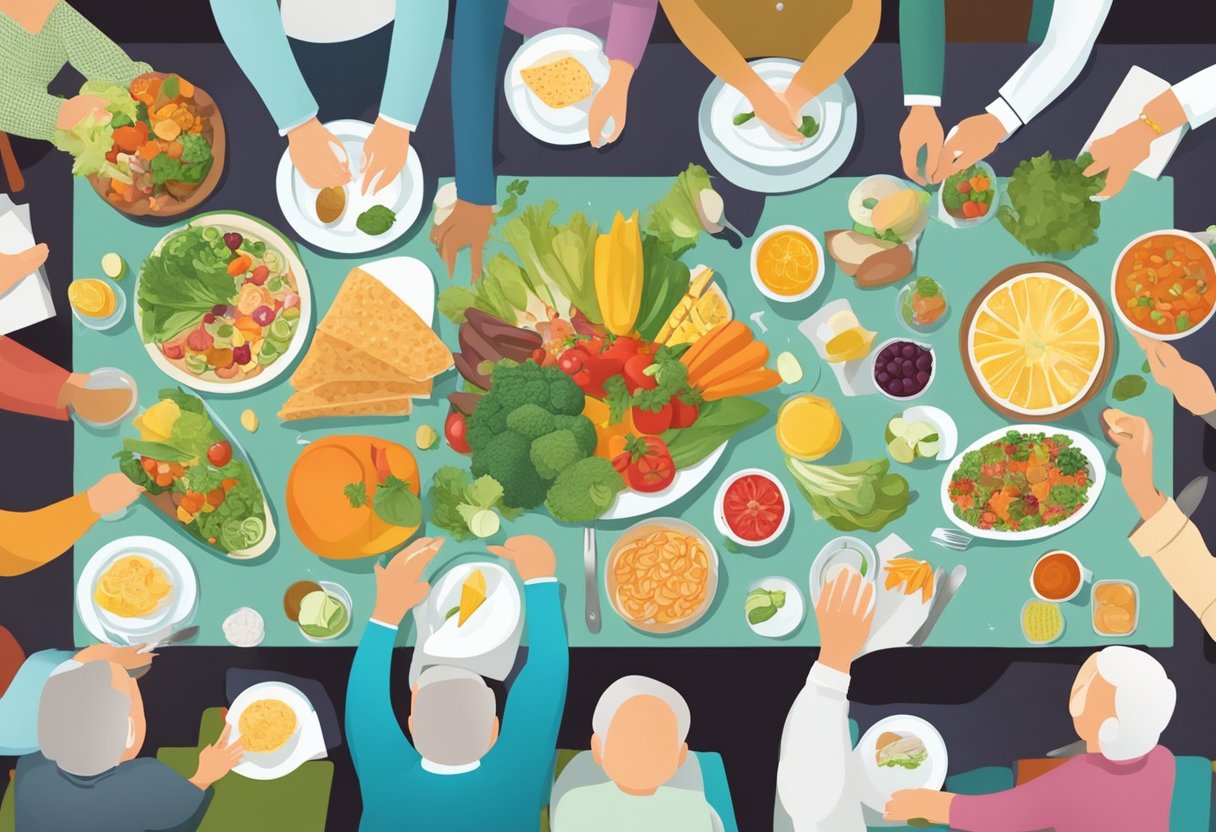One key factor in healthier eating as a senior is becoming aware of age-related alterations in appetite, metabolism, and specific nutrient needs. These adjustments can be influenced by factors such as medications, health conditions, and lifestyle habits. By recognizing these shifts, we can create personalized meal plans that effectively address our unique nutritional demands, leading to a more fulfilling and healthier life in retirement.
Key Takeaways
- Adapt your diet to meet the changing nutritional requirements of older age
- Address age-related factors such as appetite, metabolism, and nutrient needs
- Focus on personalized meal planning to support overall health and well-being in retirement
Understanding Changes in Nutritional Needs with Age
As you age, your body undergoes various physiological changes that affect your nutritional needs. In this section, we will explore the unique dietary requirements of older adults and ways to maintain a healthy eating pattern during retirement.
First and foremost, it is crucial to understand that the calorie requirements of older adults tend to decrease due to a decline in metabolism and physical activity levels. However, despite the need for fewer calories, your need for certain nutrients increases with age. These include protein, vitamin D, calcium, and vitamin B12 1.
Protein plays a significant role in maintaining muscle mass and a healthy immune system. As you age, you may experience a natural loss of muscle, known as sarcopenia 2. To support the preservation of muscle mass, aim to include lean protein sources in your diet, such as poultry, fish, beans, and nuts.
Vitamin D and calcium are essential for maintaining bone health and preventing osteoporosis. Aging can lead to a decline in the body’s ability to absorb calcium and synthesize vitamin D. To ensure optimal bone health, it is crucial to consume foods rich in these nutrients, such as salmon, fortified dairy products, and leafy greens 3.
Another essential nutrient for older adults is vitamin B12, which supports proper nerve function and red blood cell formation. As you age, your body may have a harder time absorbing vitamin B12 from food. Adding foods fortified with the nutrient, such as breakfast cereals, or considering a supplement, can help you meet your vitamin B12 needs.
In addition to these specific nutrients, prioritizing a balance of fruits, vegetables, whole grains, and healthy fats can contribute to overall well-being and help manage age-related health concerns, such as high blood pressure or diminished digestive function 4.
Below are some key points to remember for healthier eating as a senior:
- Consume adequate protein: Include lean protein sources like poultry, fish, beans, and nuts to maintain muscle mass and support the immune system.
- Prioritize vitamin D and calcium: Opt for salmon, fortified dairy products, and leafy greens to promote bone health and prevent osteoporosis.
- Include vitamin B12: Add fortified foods or supplements to your diet for proper nerve function and red blood cell formation.
- Eat a balanced diet: Choose a variety of fruits, vegetables, whole grains, and healthy fats to address age-related health concerns and maintain overall well-being.
Implementing these dietary changes can help you maintain optimal health and support your unique nutritional needs as you age.
The Basics of Healthier Eating as A Senior
As you enter retirement, it’s crucial to maintain a healthy eating routine to ensure overall wellbeing and vitality. In this stage of life, you may face unique dietary challenges, making it important to focus on consuming foods that are nutrient-dense and appropriate for your needs.
First and foremost, aim for a well-balanced diet consisting of fruits, vegetables, whole grains, lean protein, and healthy fats. Incorporate a variety of colorful fruits and vegetables to get the necessary vitamins, minerals, and antioxidants. Whole grains, such as brown rice and whole wheat bread, provide essential dietary fiber to help maintain bowel regularity and promote heart health (Harvard Health). Prioritize lean proteins like beans, fish, nuts, and eggs to support muscle strength and bone health (National Institute on Aging).
When selecting healthy fats, opt for olive oil, avocados, salmon, and seeds as they contain unsaturated fat that can improve heart health and cognitive function. Keep in mind that moderation is key when it comes to calories and portion sizes in order to manage weight and overall health.
Stay hydrated by drinking enough water and fluids throughout the day. This helps regulate body temperature, aids in digestion, and supports overall wellness. For seniors, this also helps reduce the risk of kidney stones and urinary tract infections.
Try to limit your intake of sugar, sodium, and saturated fat to prevent complications such as diabetes, hypertension, and cardiovascular disease. Choose foods that are low in added sugar and salt, and favor unsaturated fats over saturated ones.
Ensure a sufficient intake of calcium and vitamin D from dairy sources or fortified food products for strong bones and teeth. You may also want to consult a healthcare professional about potential supplements, tailored to your needs.
Finally, practice proper food safety measures to avoid foodborne illnesses. As you age, your immune system may become less efficient, so it is imperative to store, prepare, and cook food safely.
Incorporating these guidelines into your daily eating habits will contribute to a healthier and more enjoyable retirement. Remember, it’s never too late to make positive changes to your diet.
Keys to Managing and Preventing Common Health Issues
As you age, maintaining a healthy diet and lifestyle becomes even more crucial in managing and preventing common health issues such as heart disease, diabetes, cancer, and stroke. By making a conscious effort towards healthier eating and staying physically active, you can reduce the risk of malnutrition, depression, and other chronic diseases.
A well-balanced diet should include a variety of fruits and vegetables, lean proteins, whole grains, and a limited amount of added sugar and unhealthy fats. Incorporate foods rich in antioxidants, fiber, and essential nutrients to support heart health and decrease the risk of cancer. For instance, consider including sources of omega-3 fatty acids like salmon, and heart-healthy nuts like almonds or walnuts in your meals.
In addition to a balanced diet, effective diabetes management and prevention involves monitoring your blood sugar levels and making small adjustments like choosing whole grains, such as brown rice or quinoa, over refined grains. Limiting unhealthy fats like saturated and trans fats, which are mostly found in animal products like meat, cheese, and butter, can also help with healthy blood pressure levels.
To prevent malnutrition and maintain good health, it is crucial to build a healthy eating routine as you age. Plan your meals according to your unique nutritional needs, and make sure you consume a variety of nutrient-dense foods. If required, consult with a healthcare professional or a registered dietitian for personalized meal planning.
Exercise and physical activity play a vital role in preventing chronic diseases. Aim for at least 150 minutes of moderate-intensity aerobic activity or 75 minutes of vigorous-intensity aerobic activity per week, and engage in strength training exercises at least twice a week, as recommended by the National Institute on Aging. By staying active, you can also combat feelings of depression and obtain numerous physical and mental health benefits.
In conclusion, remember that healthier eating in retirement, coupled with an active lifestyle, can help in managing and preventing common health issues. Make informed choices in your diet and stay active to ensure a higher quality of life during your golden years.
Impacts of Medications on Appetite and Digestion

As you age and transition into retirement, it’s important to be aware of how medications can impact your appetite and digestion. Many older adults are prescribed multiple medications to manage chronic conditions, and some of these medications may have side effects that affect your desire to eat or your ability to digest food properly.
For example, some medications can lead to nausea, vomiting, or sensory changes that affect your sense of smell and taste. These side effects may make it difficult to enjoy food as you once did, potentially leading to reduced food intake and nutritional deficiencies.
Another factor that can affect your appetite and digestion is the physical act of chewing and swallowing. As you age, you might experience dental or oral health issues such as weakened teeth or the need for dentures. These changes can make it harder to chew and swallow food, affecting your overall food intake.
To maintain a healthy diet in retirement, consider the following tips:
- Be mindful of your medications: Speak with your healthcare provider about the medications you’re taking and any potential side effects that could affect your eating habits. They might be able to adjust the dosage or recommend alternative medications with fewer side effects related to appetite and digestion.
- Explore easy-to-chew foods: If you struggle with chewing or swallowing, choose soft, moist foods like mashed potatoes, applesauce, or cooked vegetables. You can also try pureed or blenderized foods to ensure you’re still getting adequate nutrition while maintaining your dentures or oral health.
- Focus on flavor: Enhance the taste of your meals with herbs, spices, and low-sodium seasonings to stimulate your appetite, especially if you’re experiencing taste changes due to medications.
By understanding the impacts of medications on your appetite and digestion, you can make informed choices to support a healthy diet throughout retirement. As you continue on this dietary journey, remember to consult your healthcare provider and adapt your eating habits as needed to suit your unique taste preferences and nutritional needs.
Smart Food Choices and Meal Planning Tips
As a senior, maintaining a balanced diet is crucial for overall health. Making smart food choices and having a well-thought-out meal plan can greatly contribute to better nutrition. To get started on this new lifestyle, let’s look at some tips to help you navigate your meals more efficiently.
Diversify your meals: Focus on including foods from all food groups such as vegetables, fruits, grains, protein sources, dairy products, and healthy oils. When preparing your meal, remember a colorful plate often equals a healthy meal.
Breakfast: Start your mornings off right with a balanced breakfast. Incorporating lean protein, dairy, and whole grains in your meal can help jumpstart your metabolism. For example, you might try some Greek yogurt topped with fresh berries and a small amount of granola.
Mealtime: To optimize nutrition, consider dividing your meal portions appropriately. About half your plate should be filled with colorful vegetables, a quarter with lean protein (e.g. chicken, fish, or beans), and another quarter with whole grains or starches such as brown rice or whole grain pasta.
Snacks: Choose nutrient-dense snacks to keep you satisfied in between meals. Some great options include nuts, seed mixes, carrot sticks with hummus, or a piece of fruit. Snacking can help maintain stable energy levels and keep you from overeating during meal times.
Dinner: Similar to other meals, continue focusing on variety and balance for dinner. Consider cooking dishes like grilled salmon with a side of quinoa and roasted vegetables, or a vegetable stir-fry served over brown rice.
Cooking: To make your meals healthier and more enjoyable, try experimenting with different herbs, spices, and cooking methods. Steaming, broiling, or poaching instead of deep-frying can help lower the fat content in your meals. Don’t be afraid to get creative!
Resources: To further optimize your eating habits, utilize available resources to learn about nutrition and meal planning. Track what you eat in a food diary and pay attention to nutrition labels when shopping, to ensure you make informed choices.
By following these tips and adapting your eating habits to your specific needs, you can significantly improve your nutrition and overall well-being in retirement. Invest time and effort into making smart food choices, and you will reap the rewards with better health.
Eating Well on a Budget
Eating healthily during your retirement years is essential for maintaining good health and well-being. Fortunately, you don’t need to spend a fortune to enjoy a nutritious and varied diet. In this section, we’ll offer some practical tips for eating well on a budget.
1. Plan your meals in advance. Create a weekly meal plan that includes a variety of nutrient-dense foods across all food groups: vegetables, fruits, grains, protein foods, dairy products, and oils1. This not only helps you maintain a balanced diet but also allows you to make a well-organized shopping list, which ultimately saves you money by reducing impulse purchases and food waste.
2. Prioritize seasonal produce. Buying fruits and vegetables that are in season can be more affordable, as they are typically available at lower prices and in abundance. Seasonal produce is often fresher and more flavorful too. You can take advantage of seasonal specials and consider visiting local farmers’ markets.
3. Be smart with protein choices. Protein foods can be among the most expensive items on your shopping list. Consider affordable alternatives to meat, such as beans, lentils, and eggs, which are nutritious and budget-friendly options2. Canned fish, like tuna, is also a good source of protein and can be less expensive than fresh meat.
4. Cook at home more often. Preparing your meals at home allows you to control the quality of ingredients and portion sizes. This can be more cost-effective than dining out or ordering take-out. Plus, cooking at home often results in leftovers, which you can use for quick and budget-friendly meals throughout the week.
5. Shop smart at the grocery store. Take advantage of sales, coupons, and bulk buying when these options are available for healthier food choices. Don’t forget to compare product prices and opt for generic or store brands, which often provide the same nutritional value at lower costs.
By implementing these tips and being mindful of your budget, you can enjoy a healthy and diverse diet during your retirement years without breaking the bank.
Staying Hydrated: The Importance of Fluids

As a senior, maintaining proper hydration is essential to your overall health. Staying well-hydrated supports critical bodily functions, including joint lubrication, blood pumping, and even healthy aging. In this section, we’ll explore the importance of fluids in your diet and how to effectively stay hydrated.
To ensure you’re consuming enough fluids, aim for 30 to 50 ounces of fluid per day. Remember, you don’t have to rely solely on water for hydration. Incorporate a variety of fluids into your daily routine, such as:
- Water: The most basic and essential hydration source
- Herbal tea: A flavorful, caffeine-free option
- Low-sugar fruit juice: Nutrient-rich and hydrating
- Low-sodium broth or soup: A tasty way to boost fluid intake
Additionally, consider eating water-rich foods, such as fruits and vegetables, to further support your hydration needs. Here’s a handy list of hydrating foods you can incorporate into your diet:
| Food | Water content |
|---|---|
| Cucumber | 96% |
| Watermelon | 92% |
| Strawberries | 91% |
| Grapefruit | 88% |
| Spinach | 92% |
As you age, your sense of thirst may not be as reliable as it once was. To avoid dehydration, develop the habit of sipping on fluids throughout the day, even if you don’t feel thirsty. Keep a water bottle or glass of water within reach as a reminder to stay hydrated.
Ultimately, proper hydration may help reduce the risk of chronic diseases and support a healthier, more vibrant retirement. Make the conscious effort to stay hydrated, and you’ll quickly see the benefits reflected in your overall well-being.
The Role of Family and Community in Healthy Eating

As you transition into retirement, maintaining a healthy diet is crucial for your well-being. Family and friends can play a significant role in helping you make better food choices and establish a healthy eating routine for older Americans. This support network can encourage you to try unique diets tailored to your needs.
Emphasizing Social Meals
Eating together with family and friends adds a social component to your mealtimes, making it more enjoyable and keeping loneliness at bay. Research has shown that for community-living older people, eating meals with others can hold both health and emotional benefits. Arrange regular get-togethers with loved ones or join community meal programs to share meals and foster camaraderie.
Creating a Supportive Environment
A strong support network around you can help you stick to a healthy eating plan. Involving your family and friends in creating a shopping list and preparing meals together allows everyone to learn about nutrition for older adults and share their favorite recipes. Your loved ones can also remind you to eat more fruits, vegetables, whole grains, and other nutrient-dense foods as recommended by the Dietary Guidelines for Americans.
Establishing a Routine
With the support of your community, you can work together to establish a consistent eating schedule. For example, have breakfast with your spouse or a neighbor, lunch with a friend, and dinner with your children or grandchildren. A routine ensures that you don’t skip meals and stay focused on consuming balanced meals with age-appropriate nutrients.
Remember, your friends, family, and community can make a world of difference in your journey towards healthier eating in retirement. Keep an open mind, communicate with your loved ones, and explore unique diets tailored for older adults.
Physical Activity and Healthy Eating: A Balanced Lifestyle

Combining an active lifestyle with healthy eating is essential for seniors to enjoy their retirement while maintaining overall well-being. These components work together to ensure the highest quality of life during your golden years.
Engaging in regular physical activity keeps your body strong and supports healthy aging. Experts recommend older adults participate in moderate-intensity aerobic activities, such as brisk walking or swimming, for at least 150 minutes per week. Additionally, incorporating resistance training, flexibility exercises, and balance activities into your routine helps maintain muscular strength and coordination.
Here are some suggestions for incorporating physical activity into your daily routine:
- Walk or bike to your errands.
- Join a group exercise class to stay motivated and socialize.
- Use the stairs instead of elevators.
- Begin each day with a gentle stretching routine.
Alongside physical activity, a well-balanced, nutrient-rich diet is vital. Consume a variety of fruits, vegetables, whole grains, lean proteins, and healthy fats for optimal nourishment. Guidelines for seniors include limiting sodium and saturated fat intake, while prioritizing nutrient-dense foods such as leafy greens, berries, and fish rich in omega-3 fatty acids. Ensuring adequate protein intake is crucial to preserve lean muscle mass and support overall health.
Consider the following tips when planning your meals:
- Eat the rainbow: Fill half of your plate with colorful fruits and vegetables.
- Emphasize whole grains: Opt for brown rice, quinoa, and whole grain pasta.
- Stay hydrated: Drink water regularly to maintain proper body functions.
Here is a sample meal plan for a day:
| Breakfast | Lunch | Dinner | Snacks |
|---|---|---|---|
| Whole-grain toast with avocado and a bowl of fresh berries | Grilled chicken salad with mixed greens, cherry tomatoes, and vinaigrette | Baked salmon, steamed broccoli, and a sweet potato | Low-fat yogurt and a small handful of almonds Carrot and cucumber sticks with hummus |
By maintaining a synergistic balance between exercise and healthy eating, you can ensure a physically vibrant and mentally sharp retirement. Embrace an active lifestyle, eat well, and live a fulfilling life in your senior years.
Frequently Asked Questions

What are the top foods to promote healthy aging?
To promote healthy aging, you should focus on consuming lean protein, plenty of fruits and vegetables, and limiting added sugar in your diet 1. Foods rich in fiber, such as whole grains and legumes, are also essential for supporting digestive health as you age 5. Including healthy fats like avocados and olive oil can also help your body absorb essential nutrients and improve heart health.
How can unique diets benefit seniors in retirement?
As you age, your body’s nutritional needs change. Embracing unique diets tailored to your individual needs can help prevent age-related health issues like heart disease, diabetes, and obesity, as well as provide essential nutrients for maintaining your cognitive function and overall wellness 2. Exploring different patterns of healthy eating can help you create a nutritious meal plan that best fits your body and lifestyle in retirement.
What should an elderly person avoid eating?
Elderly individuals should avoid or limit foods that are high in sodium, unhealthy fats, and added sugars, as they can contribute to health issues like high blood pressure, heart disease, and type 2 diabetes 3. Additionally, processed foods and alcohol should be consumed in moderation, as they can pose additional risks for older adults.
What is a suitable meal plan for seniors over 65?
A suitable meal plan for seniors over 65 should emphasize lean protein sources, such as chicken, eggs, and fish, a variety of fruits and vegetables, whole grains, and low-fat dairy products 2. Balance your plate by including all these food groups, and make simple adjustments to accommodate your unique dietary needs and preferences.
How much physical activity is recommended for older adults weekly?
The Centers for Disease Control and Prevention (CDC) recommend that older adults engage in at least 150 minutes of moderate-intensity aerobic activity or 75 minutes of vigorous-intensity aerobic activity per week, along with muscle-strengthening activities on two or more days per week 4. Weekly physical activity can help maintain your strength, flexibility, and balance, which are essential for healthy aging.
What specific dietary needs should seniors prioritize?
Seniors should prioritize specific dietary needs such as getting enough calcium and vitamin D for bone health, increasing fiber intake for digestive health, and consuming foods that are rich in antioxidants, like berries and green leafy vegetables, to support brain health and immunity 1. Additionally, staying well-hydrated and getting the essential vitamins and minerals your body needs should be a priority in your daily routine.
Footnotes
-
How Your Nutritional Needs Change as You Age – Healthline ↩ ↩2 ↩3 ↩4
-
Nutrition for Older Adults: Why Eating Well Matters as You Age ↩ ↩2 ↩3 ↩4
-
Nutrition as We Age: Healthy Eating with the Dietary Guidelines ↩ ↩2
-
Healthy eating, nutrition, and diet – National Institute on Aging ↩ ↩2
-
https://www.health.harvard.edu/blog/healthy-eating-for-older-adults-2019062016868 ↩






